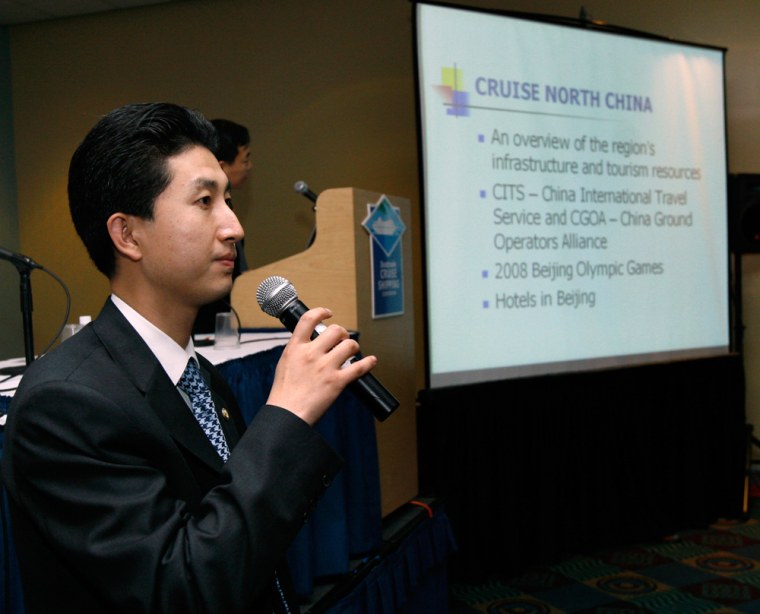The Port of Shanghai is getting a new cruise passenger terminal. Southeast Asian nations are teaming up on a Web site for cruise travelers. Officials from China are using the 2008 Olympics to promote a triangle of northern cruise ports. And don’t forget about us, says Taiwan.
Here’s Asia, cruising’s new frontier.
Representatives from the Asia-Pacific region attended the Seatrade Cruise Shipping Conference this week, beginning an aggressive marketing campaign with the goal of making Asia a competitor in the world cruise market. Many of them toured ports in Miami and Port Everglades to get a sense of U.S. port operations.
“Asia is blooming, maybe because people are too familiar with the south Caribbean or South America, and you know Europe is too expensive,” said Michael C.Y. Chang, director of the Taipei Economic and Cultural Office in New York. “Most of the countries in Asia are in a very good shape, and it’s reasonable in cost and it has major wonders and culture.”
The Asia-Pacific region lags behind the Caribbean, Europe and Alaska in notoriety as a cruise destination. But Asian officials contend there is long-term growth potential for a region with improving ports and alluring destinations such as the Great Wall of China and the jungles of Indonesia. They predict that cruising will grow 40 percent to 1.5 million passengers in 2010 in the region.
Infrastructure is mentioned as a major obstacle in terms of ship and passenger capacity, with many ports falling short of having adequate transportation in and out of port facilities, for example. Security, deployment costs and creating more interest in cruising among Asian travelers are other challenges.
The world’s two largest cruise operators, Carnival Corp. and Royal Caribbean Cruises Ltd., are establishing a presence in Asia. Carnival’s Costa Cruises already offers Asia-Pacific vacations on the Costa Allegra, and Royal Caribbean’s Rhapsody of the Seas will become the largest ship in the region when it begins its deployment in December. Both ships will target Asia as a source market.
Colin Veitch, president and chief executive of Norwegian Cruise Line, a wholly owned subsidiary of Star Cruises Group, said Star Cruises, which sails in the Asia-Pacific region, has seen bureaucratic issues related to cruising in China and a reluctance of Asians to take trips longer than two or three days.
“From listening to what goes on out there, I know Star’s operation is somewhat different, very localized, and is concentrated on very short cruises,” Veitch said during a panel discussion Tuesday. “The Asian domestic market appears to be really quite small in terms of what we understand of a cruise vacation. My personal view is I think it’s going to take some time for that to develop.”
The Port of Shanghai is addressing some of the infrastructure concerns by investing in a 300,000-square-foot terminal to handle three 80,000-gross-ton cruise ships. Shanghai’s busy port, the gateway to the Yangtze River, already is served by Costa, Princess Cruises and Holland America Line, which fall under the umbrella of Carnival.
“Cruises are quite new to the Chinese people, so it’s important for us to educate the public about the cruise ship lifestyle,” said Chen Xuyuan, president of the Shanghai International Port Group.
The Chinese are reaching out to U.S. tour operators and travel agents to promote their country, which saw 1.7 million total U.S. visitors last year and hosts the 2008 Olympics in Beijing. The port of Tianjin is billed as the gateway to Beijing. Two other ports in north China, Dalian and Qingdao, can hold large cruise ships, and both are set to have new cruise terminals within the next three years.
China also is working closely with Korea and Japan to boost cruise travel in northeast Asia.
Meanwhile, the Association of Southeast Asian Nations, or ASEAN, collaborated on a Web site to promote the Southeast Asian cruise industry, which is predicted to grow 5 percent per year until 2020, to about 820,000 passengers. The site takes advantage of the trend of customers using the Internet as a preferred method of finding vacations. It directs users to a site for each ASEAN country and gives executives access to port information.
The ASEAN Cruise Working Group also plans to train travel agents on cruising, pursue infrastructure development and build relationships with the cruise industry, said Kevin Leong, chairman of the ASEAN Cruise Working Group.
Also among the nations seeking to dip into the cruise market is Taiwan, which is heavily promoting its natural beauty and cultural and historic destinations.
Taiwan had 3.51 million visitors last year, but only 24,000 were cruise passengers. Though it does not have direct sailings to China because of political issues, Taiwan would like to increase its exposure to cruise passengers by targeting source markets of the United States, Japan, Hong Kong and Macau, said Kuo Su Tsan-Yang, deputy general of Taiwan Tourism Bureau.
Another company in the region is Seabourn Cruise Line, which services ports including Singapore, Malaysia, Vietnam. Peter Cox, Seabourn’s director of itinerary planning and development, cites security as a concern for cruise lines looking at the Asia-Pacific market.
He notes that the Bali bombings and incidents in the Philippines have led Seabourn to stop sailing to Indonesia and the Philippines for now.
That said, there is “tremendous” potential for growth in Asia, but not right away, Cox said.
“It’s going to take a long time before the local markets are developing to the extent that its going to be more than a two-, three-day cruise,” Cox said.
